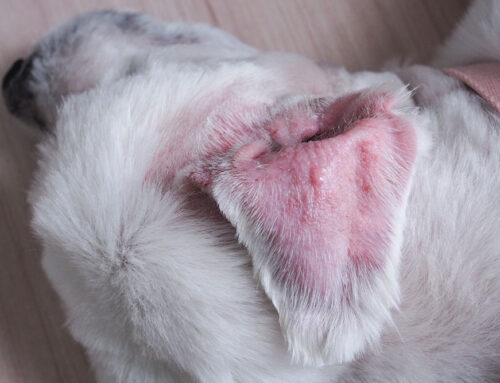Allergic to the World: Managing Environmental Allergies in Pets
Environmental allergies can be a frustrating and confusing experience for both pets and their owners. If you find yourself wondering why your pet is constantly scratching or suffering from skin issues, you’re not alone. Allergies in pets, particularly those triggered by environmental factors, are more common than many pet owners realize. At Valley Center Veterinary Clinic, we understand the impact allergies can have on your pet’s well-being and your peace of mind. We’re here to guide you through understanding, diagnosing, and managing this condition.
What Are Environmental Allergies in Pets?
Environmental allergies in pets, also known as atopy, occur when a pet’s immune system overreacts to harmless substances present in their environment. These allergens can include pollen, mold spores, dust mites, and more. The result is often allergic dermatitis, an inflammation of the skin that can cause significant discomfort for your pet. It’s important to distinguish environmental allergies from food or flea allergies, as each requires a different management approach.
What Causes Environmental Allergies?
Several factors can contribute to the development of environmental allergies in pets:
- Genetic Predisposition: Some breeds are inherently more susceptible to allergies. For instance, Labrador Retrievers and Bulldogs often show higher rates of allergic reactions.
- Immune System Dysfunction: Pets may have an exaggerated immune response to certain allergens.
- Early Exposure: Frequent exposure to specific allergens can increase sensitivity over time.
- Compromised Skin Barrier: A weakened skin barrier can allow easier penetration of allergens, leading to reactions.
Why Should You Care About Your Pet’s Environmental Allergies?
Environmental allergies can severely impact your pet’s quality of life. Chronic itching, pain, and discomfort are common side effects. Beyond these physical symptoms, allergies can cause behavioral changes, such as irritability or anxiety, due to constant discomfort. The scratching and licking associated with allergies can lead to secondary infections, such as skin and ear infections, which further complicate treatment and management. Financially, managing allergies often involves multiple veterinary visits and ongoing treatments.
Recognizing the Signs: Symptoms of Environmental Allergies
Understanding the symptoms of environmental allergies can help you recognize the issue early. Symptoms vary but typically include:
- Skin Signs: Look out for excessive scratching, licking, and chewing, along with redness, rash, or hives. Hair loss is often observed around the face, paws, and groin, and thickening of the skin may occur in chronic cases.
- Ear Signs: Repeated ear infections, head shaking, and scratching at the ears indicate possible allergy-related irritation.
- Respiratory Signs: Though less common, coughing, sneezing, and wheezing can occur in some pets.
- Other Signs: Persistent foot licking, facial rubbing, and anal gland issues can also signal allergic reactions. If left untreated, initial itching can lead to more severe symptoms, including chronic skin and ear infections, skin changes, and increased sensitivity to other allergens.
How are Environmental Allergies Diagnosed?
Diagnosing environmental allergies involves both a physical examination and specific tests. Your veterinarian will assess your pet’s skin and ear health, looking for typical signs of allergic reactions. Diagnostic tests may include:
- Skin Cytology and Scraping: To identify bacteria or yeast infections and rule out parasites.
- Allergy Testing: Intradermal skin testing or serum IgE testing can pinpoint specific allergens affecting your pet.
- Exclusion Trials: Food elimination trials help rule out food-related allergies. Our diagnostics team is equipped with tools to ensure accurate diagnosis. Learn more about our diagnostics.
Comprehensive Treatment Options
Managing environmental allergies requires a multi-faceted approach:
- Allergen Avoidance: Whenever possible, minimize exposure to identified allergens by using air purifiers and keeping pets indoors during high pollen seasons.
- Topical Therapies: Medicated shampoos and conditioners can soothe skin and treat secondary infections. Topical corticosteroids may reduce inflammation and itching effectively. Role of Topical Therapy in Allergic Dermatitis Treatment – DVM360.
- Systemic Medications: Antihistamines and corticosteroids can help manage symptoms, while immunomodulators target specific immune responses.
- Allergen-Specific Immunotherapy (ASIT): Allergy shots or sublingual therapies may gradually desensitize your pet to allergens.
- Integrative Therapies: Omega-3 fatty acids and probiotics can support skin health and immune function. Nutritional approaches are also essential; learn more about Dermatitis: Nutrition’s Role in Itchy Pets.
Daily Life Impacts of Environmental Allergies
Environmental allergies can greatly affect your pet’s daily life and your own. Pets experiencing constant itching may become frustrated or less interactive. As an owner, managing allergies can lead to emotional stress and impact household dynamics. Regular cleaning and management of allergens at home become necessary to ensure comfort for your pet and your family alike. Discover how regular grooming can help minimize allergens.
At-Home Support and Practical Tips
Taking proactive measures at home can alleviate some symptoms:
- DIY Remedies: Oatmeal baths can soothe itchy skin, while cool compresses help with inflammation.
- Environmental Control: Utilize air purifiers and vacuum regularly to reduce allergens. Keep living areas clean and dust-free.
- Dietary Adjustments: Consider hypoallergenic diets or food trials under veterinary supervision. For specific allergy care tips, Allergy Tips for Small Animals can offer additional guidance. ## Preparing for Your Vet Visit Gathering essential information before your veterinary visit helps streamline diagnosis and management:
- Bring: A detailed history of your pet’s symptoms, current medications, supplements, and previous testing results. Photos or videos of skin lesions can be particularly helpful.

Questions to Ask:
- What allergens are most likely affecting my pet?
- What are the treatment options?
- How can I manage allergies at home? These inquiries help in building a tailored management plan for your pet’s needs. During your visit, explore options like cold laser therapy to enhance treatment outcomes.
FAQs About Pet Environmental Allergies
Can my pet outgrow environmental allergies?
While most allergies are lifelong, some pets may experience reduced symptoms over time.
Is there a cure for environmental allergies?
No cure exists, but symptoms can be managed effectively.
Can human allergy medications be used on pets?
Always consult with your veterinarian, as some human medications are harmful to pets.
We’re Here for You
Managing your pet’s environmental allergies can be challenging, but you’re not alone. At Valley Center Veterinary Clinic, our compassionate team is dedicated to helping you navigate these complexities with empathy and expertise. If you have further questions or would like to discuss a management plan, schedule an appointment today. Together, we can enhance your pet’s comfort and quality of life.







Leave A Comment